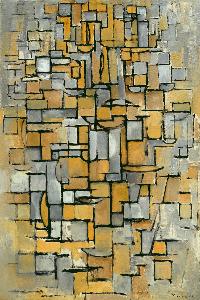Pieter Cornelis Mondriaan
Pieter Cornelis Mondriaan;Mondrian
Place: Amersfoort
Born: 1872
Death: 1944
Biography:
Early Life and Influences
Pieter Cornelis Mondriaan, known after 1911 as Piet Mondrian, was a Dutch painter and art theoretician, born on March 7, 1872, in Amersfoort, Netherlands. He is regarded as one of the greatest artists of the 20th century. Mondrian's artistic journey began with naturalistic paintings, influenced by the Dutch Impressionist manner of the Hague School.
The Evolution of Style
- Initially, Mondrian's work was characterized by representational landscapes, showcasing windmills, fields, and rivers in the style of the Dutch Impressionists.
- He later experimented with pointillism and Fauvism, leading to a search for a personal style.
- By 1908, Mondrian's work became increasingly abstract, influenced by Cubism and his encounter with the Parisian avant-garde in 1912.
Neoplasticism and Universal Beauty
Mondrian co-founded the De Stijl art movement with Theo van Doesburg, aiming to create a new kind of art for a better world. He evolved a non-representational form, which he termed Neoplasticism, seeking to express universal values and aesthetics through simple geometric elements. Key Components:**
Mondrian's work had a profound influence on 20th-century art, extending beyond abstract painting to design, architecture, and fashion. Design historian Stephen Bayley described Mondrian as the embodiment of High Modernist ideals. Notable Works:** Influence on Modern Art
Mondrian passed away on February 1, 1944, but his legacy endures as a pioneer of abstract art. His influence can be seen in various artistic movements, including Color Field painting, Abstract Expressionism, and Minimalism. Explore more of Mondrian's work on Wikioo.org. For a comprehensive guide to his life and art, visit Piet Mondrian's Wikipedia page.Legacy














